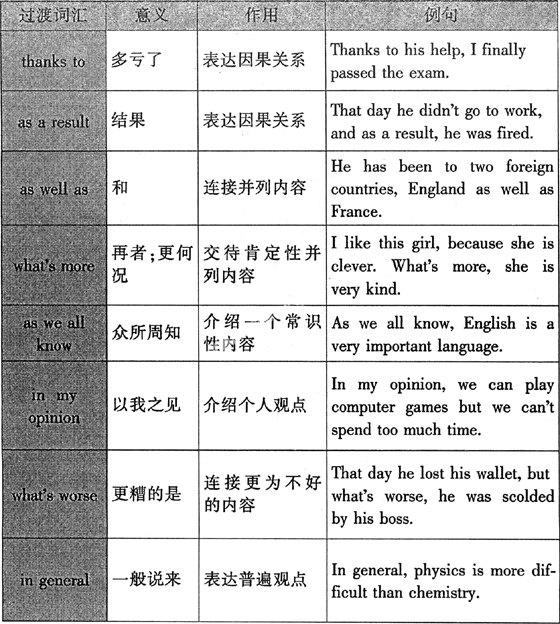如何增强书面表达行文连贯性
郝昌明
众所周知,行文之间是否具有连贯性是书面表达的重要评分标准,是书面表达能否获得高分的一个高级要求。本文介绍几种行之有效的增强行文连贯性的手法。
一、贴切使用过渡性词汇
贴切使用过渡性词汇可以大幅度增强书面表达行文连贯性,提高书面表达可读性,它不仅包括各种从句引导词,也包括起过渡作用的插入语和起连接作用的副词。同学们可根据体裁与题材的需要贴切使用过渡性词汇。记叙文应着重用好one day/morning/afternoon/evening/night, in the morning/ afternoon/evening等过渡性词汇和first, second, then, suddenly, finally/at last/in the end等表示顺序的过渡性词汇。议论文应着重用好:列举肯定性内容的besides, whats more, at the same time, in the meanwhile; 列举否定性内容的whats worse, to make the matter worse, worse than all, worse than ever, worse still; 表达个人观点的in my opinion, in the opinion of me, in the eyes of me;由肯定内容向否定内容过渡的however;介绍常识性观点的as we all know, as is known to all, generally speaking, in general;表示总结的in a word, overall, altogether。人物介绍文应着重用好:介绍人物简历的in the past, at present, in the future; 介绍人物在不同领域取得不同成果的not only…but also…, also, too, in addition。说明文应着重用好:介绍说明顺序的first, then, finally/at last/in the end;介绍不同特点的besides, whats more, whats worse, whats worst, in the meanwhile, at the same time。数据式图表作文应着重用好:表示对比的while, however, but, yet;表示因果关系的therefore, so, thus。
一些过渡性词汇,表达效果好,使用频率高,恰当使用对增强行文连贯性,提高观点可信度可起到立竿见影的效果。请看下表:

同学们应增强这些过渡性词汇使用意识,养成使用习惯,确保在每次的书面表达实践和高考书面表达考试中用上几个,以提高书面表达得分。
二、正确使用文首交待句和文末总结句
为自然顺畅地过渡下文,使文章不显得突然意外,同学们应学会使用文首交待句和文末总结句。文首交待句就是位于文章开头对文章内容进行总体介绍使读者对其有大致了解的句子。同学们可在文章开头用肯定陈述句对全文内容做简要介绍,以使读者对全文内容有一个基本了解。当然写文首交待句时因情节尚未铺开,内容尚未介绍,可适当写得笼统概括一些。
人物介绍文文首交待句可写成…is a/an…;单位介绍文文首交待句可写成Our…is a/an…; 记叙文文首交待句可写成Last Sunday we paid a visit to…;议论文文首交待句可写成Recently our class has held a heated discussion on whether we can…;求职信文首交待句可写成I learned from the newspaper that your company wanted to hire a/an…and I want to apply for it;说明文文首交待句可写成An English-Chinese dictionary is a useful tool for us to learn English.
文末总结句就是位于文章末尾对全文内容进行总结的句子。此时因全文情节已经铺开,内容已做介绍,读者对文章非常了解,因此宜写得具体明确一些。人物介绍文文末总结句可写成Such is…, a hardworking, kind and successful…;单位介绍文文末总结句可写成Such is our…, a beautiful and famous…;记叙文文末总结句可写成 I have learned a lot from the visit;议论文文末总结句可写成…has its advantages and disadvantages, we can…but we cant….或…has its strengths and weaknesses, so we can…but we should…; 求职信文末总结句可写成If I can get the job, Ill work hard. 说明文文末总结句可写成So an English-Chinese dictionary is really useful to us, we should make good use of it to learn English.
三、正确使用段首交待句
为使文章层次更清晰,行文更连贯,同学们应学会使用段首交待句,如写记叙文介绍人物简历这一段时可用…had a wonderful past.为段首交待句; 写议论文介绍支持性观点时可以使用Some…support the…为段首交待句;写议论文介绍反对性观点时可用However, some…dont think so.;写议论文反映社会问题时可用Other…dont think so. They hold the view that…为段首交待句。

